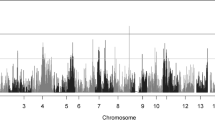Abstract
Usher syndrome (USH) is an autosomal-recessive disease characterized by neurosensory deafness and progressive retinitis pigmentosa. So far, three clinical types of Usher syndrome have been defined, and are caused by defects at more than eight loci. We report the linkage analysis of seven Lebanese families with Usher syndrome, two with type I (USH1) and five with type II (USH2). We demonstrate that one family is linked to the USH1C locus, a rare form of USH1 only reported in the French Acadian population. Linkage analysis of the five USH2 families with recently mapped loci allowed us to reduce the USH2A candidate region to a very small interval flanked by D1S2646/D1S2629 and D1S2827. Furthermore, haplotype comparison between the different families suggests a founder effect for the USH2A mutation among the different Lebanese ethnic groups, while a genetic heterogeneity is noted for Usher syndrome type I.
Similar content being viewed by others
Author information
Authors and Affiliations
Additional information
Received: 9 January 1998 / Accepted: 23 March 1998
Rights and permissions
About this article
Cite this article
Saouda, M., Mansour, A., Bou Moglabey, Y. et al. The Usher syndrome in the Lebanese population and further refinement of the USH2A candidate region. Hum Genet 103, 193–198 (1998). https://doi.org/10.1007/s004390050806
Issue Date:
DOI: https://doi.org/10.1007/s004390050806




